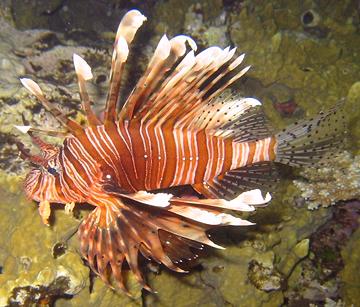 [Red Lionfish; Pterois volitans |
Common Lionfish, Devil Firefish; Pterois miles]
[Red Lionfish; Pterois volitans |
Common Lionfish, Devil Firefish; Pterois miles]
These fish, native to the Indo-West Pacific region, are now serious invasives in the Gulf of Mexico, the Caribbean, and along the South Atlantic coast of the United States. They very much deserve being eaten, as they eat just about everything else. They are severely degrading the reef ecology of the region, and are threatening important fisheries. They are insatiable eaters, they just don't stop, and many caught for study show distinct signs of obesity. The Red Lionfish is the most common, with the very similar Common Lionfish composing just 7% of the population. They have no significant natural predators here, but some large Groupers do occasionally eat Lionfish. In Honduras there has been some effort to train sharks to eat them, since sharks are thought immune to their venom.
The only effective method of control appears to be to eat them. Several organizations are urging people to eat Lionfish, and it is considered a very good eating fish, quite popular in its native range. The problems are, they are reef fish, so commercial fishing gear is useless to catch them, and they don't take baited hooks - and, they have 18 highly toxic spines. The venom can rarely kill a healthy adult human, but is very serious. Once the spines are cut off with kitchen shears, the Lionfish can be handled and cooked like any other fish.
Acquiring Lionfish for restaurants and fish markets presents problems. The only current sources are from spear fishers and lobstermen, as they sometimes enter lobster traps to take the bait. One restaurateur is working to develop traps specifically for Lionfish to improve availability. The company that makes the Roomba is developing an underwater robot to zap and suck up Lionfish on a commercial scale - Lionfish fear nothing, so they won't flee from a predatory robot. IUCN Red List status NE (Not Evaluated). Photo by Hannes Grobe/AWI distributed under license Creative Commons Attribution v3.0 Unported.
More on Varieties of Fish
(very large page).
Lionfish has very white, mild flavored flesh with a pleasant meaty texture. It flakes well and is a little firmer than Halibut. It has been described as tasting somewhere between Grouper and Mahi Mahi. It is quite popular as a food fish in its native range. Lionfish is high in Omega 3 fatty acids and low in mercury, since Lionfish feed fairly low on the food chain. There has been some alarm about ciguatera toxin, but so far there has been no reported case, with thousands of Lionfish having being eaten, especially right after Lionfish catching contests.
This fish is cooked by pan frying, deep frying, steaming, baking or microwaving. It can be cooked whole (except for the spines) or filleted (with or without skin). It is also used as ceviche and sashimi, as well as for taco filling. Some people detox the spines (350°F/175°C for about 10 minutes) and use them as toothpicks for Lionfish cubes on the buffet. No risk here, Lionfish toxin is not dangerous when ingested.
No Lionfish live anywhere near Southern California. The Pacific Coast is not a reef environment, you step off the dock directly onto the high seas - it's even safe to eat our Barracuda. Nobody is shipping Lionfish here either, due to inadequate supply. Consequently, I have composed the information below from a number of reliable sources. I do this because I know it's important to the reef environment that people become interested in eating Lionfish and developing adequate harvest methods.
Buying: Right now, it's necessary to know someone who spear fishes, or a lobsterman, as the supply isn't yet up to demand. Current harvesting methods are not efficient. I will be watching the frozen fish cases in the Asian markets, though. It's an Indo-West Pacific fish, so if a North American market develops, they will surely be shipped here, probably from Vietnam.
IF you are unfamiliar with preparing whole fish, see our page Cleaning & Filleting Round Fish .
Disarming: Handle this fish very carefully until it is safely disarmed. Long barbecue tongs may be helpful. With kitchen shears, cut off all the venomous spines: 13 dorsal, 2 pectoral (bottom fins, leading edge) and 3 anal (leading edge). Dispose of these in a way that assures there will be no accidents. They are harmless unless they puncture the skin. After disarming, you can safely clean the fish pretty much like any other round fish that's about 10 inches long. Some expert Lionfish handlers fillet without removing the spines, just keeping the fish flat on the cutting board so the spines aren't sticking up.
Scales: This fish doesn't have scales, or at least not enough of them to be a bother.
Cleaning: Nothing at all unusual here - just use the standard methods for other smallish fish.
Fillet: This fish is reasonably easy to fillet, as it has a coherent fin and bone structure. Most people fillet this fish leaving the ribs attached to the backbone. Some do not include the thin part over the ribcage in their fillet.
Skin: The skin may be left on or removed. To remove it, you outline your fillet with the knife, making shallow cuts all the way around. Then, before cutting deeper, just pry the skin up at the top front and peel it off towards the tail. Then continue cutting your fillet.
Yield: I haven't been able to study this first hand, but from the videos I've viewed, probably around 40%, as the head is quite large.
Stock: I have seen no references to making stock from this fish.
sf_lionz* 161106 - www.clovegarden.com